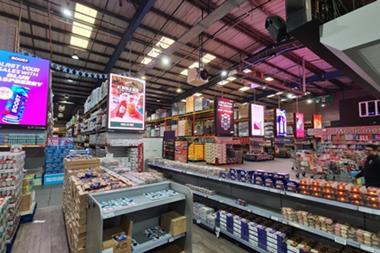The Competition Commission claims there is “no evidence to suggest the financial viability of the wholesale sector is seriously under threat”.
An initial look at our 2008 ranking of the 30 biggest UK wholesalers suggests the commission has a point - and that its chairman Peter Freeman may not have been so wide of the mark after all when he used Bestway chairman Sir Anwar Pervez’s appearance in The Sunday Times Rich List to illustrate wholesale’s rude health.
Profits and more importantly margins are up, the former by 35.2% to £299.7m overall and the latter from 1.5% to 1.8% . Total turnover has also risen by 3.2% - above the 2.1% rate of inflation - to £19.8bn.
Good news surely?
Well, not entirely. A closer look at the league table over the page reveals a far more troubling and complex picture of a sector that, as John Murphy, director general of the Federation of Wholesale Distributors put it bluntly, is “treading water and working hard just to hold its market position”. Yes, some of the figures are encouraging but plenty are not, especially when they are considered in the context of last year’s performances.
The past 12 months was one of the most turbulent years for wholesale in recent memory. As well as arrests, firings and even the odd natural disaster, the sector was hit by a wave of consolidation.
The likes of Palmer & Harvey McLane, Booker and the Musgrave Group snapped up smaller wholesalers in a bid to drive margin growth. This year the sector is likely to see more of the same, predicts Booker boss Charles Wilson. Whether this consolidation will work is another question.
Though the average profit margin has risen for a second year in a row to 1.8%, it’s still shockingly low, especially when compared with Tesco’s 5.7%. The 3.2% rise in total turnover, meanwhile, actually represents a slowdown in growth compared with the 5.3% increase recorded this time last year.
Times are harder than Freeman realises, says Murphy. “Last year we recorded a 5.3% rise in sales and something akin to that would have been more encouraging for our members at the present time.”
He puts improved margins down to “increasing professionalism in a more pressured marketplace”. This year’s ranking bears this out with the few success stories shining out in stark contrast to those of wholesalers clearly struggling to remain competitive.
Though sales growth is only just tracking above inflation, the 20% growth in average margin suggests that these wholesalers at least are successfully stripping out costs and selling higher-margin goods - if not higher volumes of goods.
More than half The Big 30 wholesalers have managed to grow their profit margins over the past year, including the top two: P&H’s increased from 0.6% to 0.7% and Booker’s from 0.6% to 1%.
The business that has been most successful in driving profitability has been Nisa-Today’s member and oriental specialist wholesaler Wing Yip (see above). On sales up 4.4% to £84.9m, Wing Yip has boosted its profit by an impressive 60%, giving it a market-leading margin of 6.6%.
However, others are not faring quite so well. While two, JW Filshill and Elbrook Cash and Carry, maintained the same margins, nine companies saw theirs eroded. The highest-profile casualty was Costco, its margin slumping from 2.8% to 2%. East End Foods, meanwhile, experienced the sharpest fall, from 1.8% to just to 0.3%.
Sales-wise the picture is similarly mixed. For some players, such as Musgrave Retail Partners GB, formerly MBL, it has been a year of transition and this has been reflected in the figures. Turnover has slumped from £1.8bn to £1.25bn, relegating it from third to sixth place in the chart, as it has transformed itself from a retailer and wholesaler into a pure wholesaler.
Last year was also eventful for both the largest wholesalers. Industry giant P&H tops the list in terms of turnover, with growth of 12.7% to £3.98bn, thanks to higher sales and its purchase of T&A Symonds in August. (The Yeovil-based delivered operator had sales of £92.2m last year. )
Eighteen months ago, Etherington began a strategic review of the business and industry observers will expect to see P&H’s profit margin grow more significantly once Etherington’s changes have taken effect.
“We’re obviously delighted to be top of The Big 30 again,” says CEO Chris Etherington (see interview p36). “This will be a tough year for wholesale but so is every other year, so we can’t afford to rest on our laurels.”
Second-placed Booker also flexed its muscle in terms of acquisitions, with the purchase of internet wholesaler Blueheath in a surprise reverse takeover. The upshot was Booker returning to the public market by taking up Blueheath’s listing on the AIM for small companies.
This year it will have to graduate to the London Stock Exchange because of the sheer size of its turnover, though it fell 0.9% to £3.01bn. In readiness, chief executive Charles Wilson has been strengthening his board, last month appointing Cobra beer founder Lord Bilimoria to the board as a non-executive director.
Wilson has had a bit of a head start on his rival at P&H in turning the company round and as such has made greater strides in driving up profitability. This year Booker recorded a pre-tax profit of £29.7m compared with a pre-tax loss of £7.6m the previous year.
It has also increased its margin from 0.6% to 1%, closer to the industry average, and this year aims to push this further by really squeezing the benefits out of the Blueheath deal and starting to make its mark in the delivered wholesale sector.
Its return to the public market has not been all plain sailing. Just last week its share price took a major hit after it produced its latest trading figures. For the 16 weeks to January 4, Booker’s sales grew just 1.3%. The business was also hit by a 7.9% fall in tobacco sales, though like-for-like sales excluding tobacco were up 2.4% .
Wilson defends its performance as “solid in a challenging market” and insists “Booker continues to make good progress”. Even rival cash & carry boss Steve Parfett, MD of Parfetts Cash & Carry, agrees Booker’s figures are “acceptable” and claims the share performance demonstrates a lack of understanding of the “low-margin but essentially stable and predictable business”.
But tobacco sales were always going to be an issue for wholesalers this year following the introduction of the ban on smoking in public places and the raising of the legal age for purchasing tobacco from 16 to 18.
Wilson himself admitted to The Grocer last year that Booker wanted to become less reliant on tobacco and was hoping to do this by improving its fresh range, introducing the economy Euro Shopper range and a new pre-packed own label fresh meat range.
Despite Booker’s insistence that it was not hit that badly because tobacco sales were now a smaller part of the mix, there’s no doubt the smoking ban has had a bigger impact on sales than many industry watchers and even the tobacco suppliers were predicting.
“Some of the big tobacco companies were telling us there would be an initial drop in sales but they would begin to recover after a few months,” says Parfett. “This just hasn’t been the case. Sales are still well down and the Booker figures just confirm this is happening across the board.”
Parfett has long been a vocal advocate of a more level playing field with the big supermarkets and says he was disappointed with the commission’s view of the wholesale sector in its provisional findings.
The commission highlighted a 13% price differential between the price wholesalers can expect to pay suppliers compared with the price major multiples pay. In the previous investigation this figure was 10%. However, the commission did not flag it up as a problem that required any remedial action.
This was a major oversight, believes Parfett. “There is no doubt we are in a tough trading environment,” he says. “But there is a danger that wholesalers could start to be seen in the same way as some people talk about moaning farmers who are never happy. Although margins can seem low, this sector is generally quite stable and predictable. It offers a return on capital expenditure (ROCE) that is to die for compared with many other industries.” Wholesale is “by no means a basket case”, he adds.
Others such as Hancocks Cash & Carry would agree. The confectionery specialist has made a welcome return to The Big 30, with sales growth of 2.9% to £84.4m and profitability up 45% from £1.04m to £1.51m. It attributes its impressive performance to a new strategy focused on offering a point of difference from the multiples, particularly over key trading periods such as Christmas and Easter.
So it has switched its focus from standard mainstream confectionery brands, which tend to be subject to major discounts at the big supermarkets, to exclusive ranges for independent retailers.
“By seeking to be different we really are able to help our customers build their confectionery sales,” says Hancocks purchasing director Richard Brittle.
But if 2007 was the year product mix became a core issue, 2008 looks set to be dominated by rising costs and the torrid state of the wider economy. With energy bills and food prices expected to rise, wholesalers will find it tough to keep prices down and enable customers to compete more effectively with the supermarkets.
The continued upward trend in oil prices will come as a particular blow to delivered operators. Last April IGD predicted that delivered wholesaling would overtake the more traditional cash and carry format in sales within three years. It may well take longer if distribution costs continue to spiral and therefore the prices wholesalers can charge retailers also rise.
This is a concern for Booker as it seeks to grow its delivered business. “We do have the best of both worlds, but it is important for us to improve what customers can get in cash and carry while we improve the delivery side,” says Wilson. “If we can do a better job for all customers we can build ourselves a healthier business.”
Tighter economic conditions will also force independents to spend a lot of time trawling wholesalers searching for the best deals on key products.
“It’s more important than ever that we get retailers to do more of their business with us. Wholesalers have to make the most of retail clubs and fascia schemes,” says Parfett. “It’s not always easy but we need to find retailers who are prepared to listen to the expertise we can provide and who are prepared to invest in the future success of their businesses.”
For some, of course, market consolidation may well provide part of the solution in the wake of successful tie-ups last year. However not every marriage works, warns Wilson.
“There is too much capacity at the moment and this will have to be taken out of the market,” he says. “But people shouldn’t rush into consolidation. Margins are too low in this sector and people have to be very careful of getting into the wrong partnerships.”
While it is too early to assess fully the various merits of last year’s major acquisitions, one major wholesale tie-up has clearly not worked out the way the interested parties would have hoped.
Last January Makro UK joined the wholesale arm of Nisa-Today’s. The deal sent shockwaves through the industry as the potential impact of Makro’s £1bn-plus turnover on the Today’s Group’s buying power and the likely response from rival buying group Landmark Wholesale were speculated over.
But 12 months later it has emerged that the two companies have stopped joint negotiations. Makro will remain a member of Today’s but with a much more limited remit than initially envisaged. The size and complexity of the two businesses meant they had not gelled as they would have liked, admitted Today’s Group MD Rodney Hunt.
This year, M&A activity is likely to be as frenetic as ever, but it won’t be the only avenue wholesalers explore as they square up to what looks set to be an even more challenging year.
Murphy remains upbeat about the prospects for the sector as a whole. “Wholesalers will only continue to improve margins by buying better, selling more and keeping a tight control on costs,” he says.
For some, conditions could prove too challenging - and survival will be the number one priority.
So the Competition Commission did have a point. The market is still viable - for now. With the outlook decidedly mixed for many of the country’s biggest wholesalers, the long-term future of the sector looks far less certain.
Sign in to comment on this article
Not logged in before? Register for FREE guest access today.
You will be able to:
- Read more stories
- Receive daily newsletters
- Comment on stories
Advert



















No comments yet